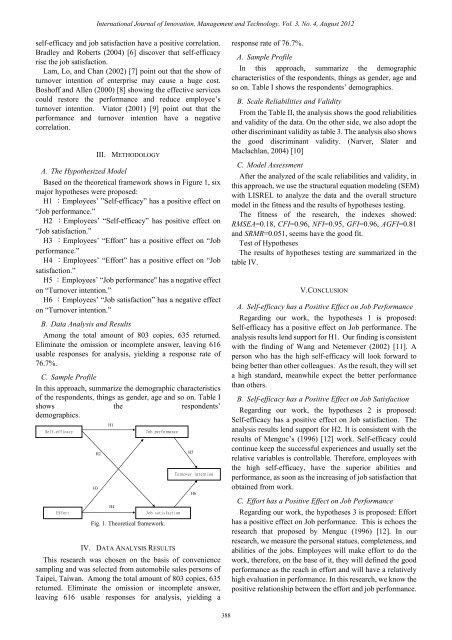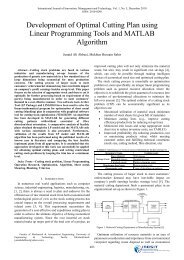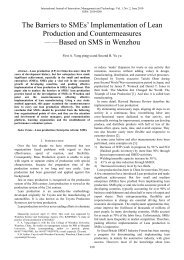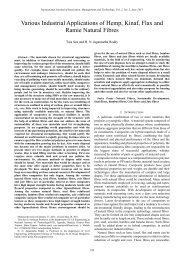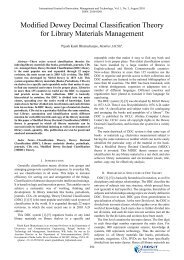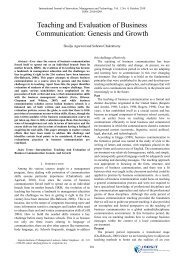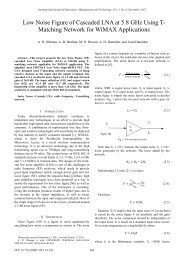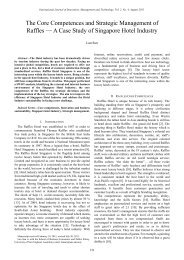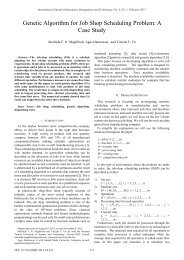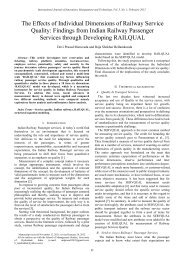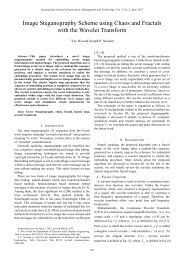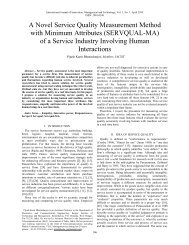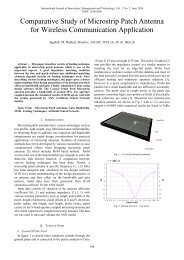Self-Efficacy, Effort, Job Performance, Job Satisfaction, and ... - ijimt
Self-Efficacy, Effort, Job Performance, Job Satisfaction, and ... - ijimt
Self-Efficacy, Effort, Job Performance, Job Satisfaction, and ... - ijimt
You also want an ePaper? Increase the reach of your titles
YUMPU automatically turns print PDFs into web optimized ePapers that Google loves.
International Journal of Innovation, Management <strong>and</strong> Technology, Vol. 3, No. 4, August 2012<br />
self-efficacy <strong>and</strong> job satisfaction have a positive correlation.<br />
Bradley <strong>and</strong> Roberts (2004) [6] discover that self-efficacy<br />
rise the job satisfaction.<br />
Lam, Lo, <strong>and</strong> Chan (2002) [7] point out that the show of<br />
turnover intention of enterprise may cause a huge cost.<br />
Boshoff <strong>and</strong> Allen (2000) [8] showing the effective services<br />
could restore the performance <strong>and</strong> reduce employee’s<br />
turnover intention. Viator (2001) [9] point out that the<br />
performance <strong>and</strong> turnover intention have a negative<br />
correlation.<br />
III. METHODOLOGY<br />
A. The Hypothesized Model<br />
Based on the theoretical framework shows in Figure 1, six<br />
major hypotheses were proposed:<br />
H1 :Employees’ ”<strong>Self</strong>-efficacy” has a positive effect on<br />
“<strong>Job</strong> performance.”<br />
H2 :Employees’ “<strong>Self</strong>-efficacy” has positive effect on<br />
“<strong>Job</strong> satisfaction.”<br />
H3 :Employees’ “<strong>Effort</strong>” has a positive effect on “<strong>Job</strong><br />
performance.”<br />
H4 :Employees’ “<strong>Effort</strong>” has a positive effect on “<strong>Job</strong><br />
satisfaction.”<br />
H5 :Employees’ “<strong>Job</strong> performance" has a negative effect<br />
on “Turnover intention.”<br />
H6 :Employees’ “<strong>Job</strong> satisfaction” has a negative effect<br />
on “Turnover intention.”<br />
B. Data Analysis <strong>and</strong> Results<br />
Among the total amount of 803 copies, 635 returned.<br />
Eliminate the omission or incomplete answer, leaving 616<br />
usable responses for analysis, yielding a response rate of<br />
76.7%.<br />
C. Sample Profile<br />
In this approach, summarize the demographic characteristics<br />
of the respondents, things as gender, age <strong>and</strong> so on. Table I<br />
shows the respondents’<br />
demographics.<br />
<strong>Self</strong>-efficacy<br />
<strong>Effort</strong><br />
H3<br />
H2<br />
H1<br />
H4<br />
<strong>Job</strong> performance<br />
<strong>Job</strong> satisfaction<br />
Fig. 1. Theoretical framework.<br />
IV. DATA ANALYSIS RESULTS<br />
H5<br />
Turnover intention<br />
This research was chosen on the basis of convenience<br />
sampling <strong>and</strong> was selected from automobile sales persons of<br />
Taipei, Taiwan. Among the total amount of 803 copies, 635<br />
returned. Eliminate the omission or incomplete answer,<br />
leaving 616 usable responses for analysis, yielding a<br />
H6<br />
response rate of 76.7%.<br />
A. Sample Profile<br />
In this approach, summarize the demographic<br />
characteristics of the respondents, things as gender, age <strong>and</strong><br />
so on. Table I shows the respondents’ demographics.<br />
B. Scale Reliabilities <strong>and</strong> Validity<br />
From the Table II, the analysis shows the good reliabilities<br />
<strong>and</strong> validity of the data. On the other side, we also adopt the<br />
other discriminant validity as table 3. The analysis also shows<br />
the good discriminant validity. (Narver, Slater <strong>and</strong><br />
Maclachlan, 2004) [10]<br />
C. Model Assessment<br />
After the analyzed of the scale reliabilities <strong>and</strong> validity, in<br />
this approach, we use the structural equation modeling (SEM)<br />
with LISREL to analyze the data <strong>and</strong> the overall structure<br />
model in the fitness <strong>and</strong> the results of hypotheses testing.<br />
The fitness of the research, the indexes showed:<br />
RMSEA=0.18, CFI=0.96, NFI=0.95, GFI=0.96, AGFI=0.81<br />
<strong>and</strong> SRMR=0.051, seems have the good fit.<br />
Test of Hypotheses<br />
The results of hypotheses testing are summarized in the<br />
table IV.<br />
V. CONCLUSION<br />
A. <strong>Self</strong>-efficacy has a Positive Effect on <strong>Job</strong> <strong>Performance</strong><br />
Regarding our work, the hypotheses 1 is proposed:<br />
<strong>Self</strong>-efficacy has a positive effect on <strong>Job</strong> performance. The<br />
analysis results lend support for H1. Our finding is consistent<br />
with the finding of Wang <strong>and</strong> Netemever (2002) [11]. A<br />
person who has the high self-efficacy will look forward to<br />
being better than other colleagues. As the result, they will set<br />
a high st<strong>and</strong>ard, meanwhile expect the better performance<br />
than others.<br />
B. <strong>Self</strong>-efficacy has a Positive Effect on <strong>Job</strong> <strong>Satisfaction</strong><br />
Regarding our work, the hypotheses 2 is proposed:<br />
<strong>Self</strong>-efficacy has a positive effect on <strong>Job</strong> satisfaction. The<br />
analysis results lend support for H2. It is consistent with the<br />
results of Menguc’s (1996) [12] work. <strong>Self</strong>-efficacy could<br />
continue keep the successful experiences <strong>and</strong> usually set the<br />
relative variables is controllable. Therefore, employees with<br />
the high self-efficacy, have the superior abilities <strong>and</strong><br />
performance, as soon as the increasing of job satisfaction that<br />
obtained from work.<br />
C. <strong>Effort</strong> has a Positive Effect on <strong>Job</strong> <strong>Performance</strong><br />
Regarding our work, the hypotheses 3 is proposed: <strong>Effort</strong><br />
has a positive effect on <strong>Job</strong> performance. This is echoes the<br />
research that proposed by Menguc (1996) [12]. In our<br />
research, we measure the personal statues, completeness, <strong>and</strong><br />
abilities of the jobs. Employees will make effort to do the<br />
work, therefore, on the base of it, they will defined the good<br />
performance as the reach in effort <strong>and</strong> will have a relatively<br />
high evaluation in performance. In this research, we know the<br />
positive relationship between the effort <strong>and</strong> job performance.<br />
388


